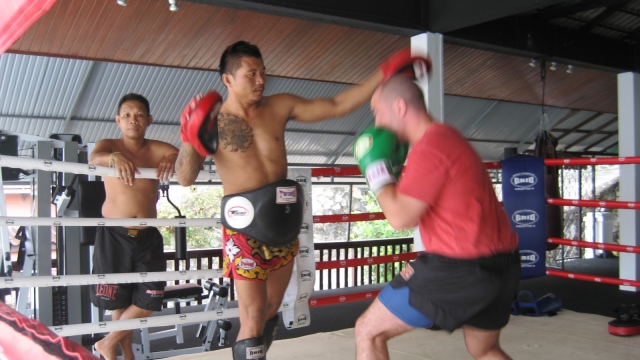Welcome to the ultimate showdown, where the world’s most powerful combat sports collide in a battle royale of skill, technique, and raw athleticism. Boxing, Muay Thai, Kickboxing, and Jiu Jitsu stand at the forefront of this fierce competition, each with its own arsenal of moves and strategies to dominate the ring. In this article, we delve into the depths of these disciplines, exploring their unique origins, strengths, and how they have revolutionized the world of combat sports. Will there be a clear victor, or will they coexist as complementary forces? Join us as we unlock the secrets behind the powerhouses that are Boxing, Muay Thai, Kickboxing, and Jiu Jitsu.
The Art of Striking: Boxing, Muay Thai, and Kickboxing
Boxing, Muay Thai, and Kickboxing are three combat sports known for their exceptional striking techniques and electrifying displays of power. Each discipline possesses its own unique set of skills and techniques, making them all integral parts of the battle royale in the world of combat sports.
Boxing, often referred to as the "sweet science," focuses primarily on the use of fists. It is a sport that demands precision, speed, and footwork. Boxers utilize a wide array of punches, including jabs, hooks, uppercuts, and crosses, to effectively navigate their way through their opponent’s defenses. The defensive skills in boxing are just as important as the offensive ones, with fighters employing techniques like bobbing, weaving, and clinching to evade strikes and counter effectively.
On the other hand, Muay Thai, also known as the "art of eight limbs," combines the use of fists, elbows, knees, and shins. It is a highly dynamic and intense sport originating from Thailand. Praised for its raw power and relentless pace, Muay Thai fighters employ strong punches, devastating elbow strikes, bone-crushing knee strikes, and powerful kicks. The versatility of strikes in Muay Thai allows fighters to attack their opponents from various angles, making it an incredibly dangerous discipline in close-range combat.
Kickboxing, which stems from a combination of boxing and traditional karate, incorporates punches and kicks to create a thrilling and action-packed sport. Kickboxers are known for their explosive kicks and lightning-fast punches, enabling them to generate tremendous power and knock out opponents. The art of kickboxing emphasizes a balance between offense and defense, with fighters utilizing evasion techniques, blocking, and counterattacks to gain a strategic advantage over their opponents.
In conclusion, boxing, Muay Thai, and kickboxing are all exquisite forms of striking that captivate fans with their beauty, power, and display of technical proficiency. While each discipline possesses its own distinct characteristics, they all contribute to the electrifying world of combat sports, forming an essential part of the battle royale in the ring.
The Art of Grappling: Jiu Jitsu
Jiu Jitsu is a highly effective martial art that focuses on grappling techniques and ground fighting. Originating in Japan and later popularized in Brazil, Jiu Jitsu has become a cornerstone of mixed martial arts (MMA) competitions. With its emphasis on leverage and technique, Jiu Jitsu provides individuals with the ability to overcome larger opponents through skillful maneuvers and submissions.
One of the key aspects of Jiu Jitsu is its utilization of joint locks and chokeholds. Practitioners learn how to manipulate their opponent’s joints, putting pressure in strategic areas to force them into submission. By understanding the body’s mechanics and utilizing their own body weight to their advantage, Jiu Jitsu practitioners can neutralize even the most aggressive opponents.
jiu jitsu classes near me
Furthermore, Jiu Jitsu places great importance on ground fighting techniques. Unlike striking-based martial arts such as boxing or kickboxing, Jiu Jitsu focuses on controlling the opponent on the ground and transitioning between various positions. This allows practitioners to effectively defend themselves and launch counterattacks while in close proximity to their opponent.
Another unique aspect of Jiu Jitsu is its emphasis on constant training and sparring. In order to truly master the art, practitioners engage in live rolling sessions, where they apply techniques against resisting opponents. Through this intense and realistic training, Jiu Jitsu practitioners sharpen their skills, adapt to unpredictable situations, and develop a deep understanding of the art’s intricacies.
In conclusion, Jiu Jitsu plays a vital role in the world of martial arts and combat sports. Its focus on grappling techniques, joint locks, and ground fighting make it an indispensable skill for both self-defense and competition. With its ability to level the playing field against larger opponents, Jiu Jitsu empowers individuals to harness their physical and mental strength to overcome adversity.
Choosing the Right Martial Arts Discipline
When it comes to choosing the right martial arts discipline, there are several factors to consider. Firstly, each discipline offers a unique set of techniques and strategies, so it’s essential to understand what you hope to achieve. Whether you are interested in developing your striking abilities or mastering the art of grappling, identifying your goals will guide you in making the right decision.
Additionally, it is crucial to consider your personal preferences and physical capabilities. Some individuals may find themselves drawn to the explosive and fast-paced nature of boxing, while others may prefer the versatility and clinch work of Muay Thai. Alternatively, those who enjoy a mix of striking and grappling may find kickboxing or Jiu Jitsu to be the perfect fit. By understanding your preferences, you can select a martial arts discipline that aligns with your interests and strengths.
Lastly, it can be beneficial to seek out a reputable instructor or training facility. The guidance and expertise of a knowledgeable teacher can make a significant difference in your martial arts journey. Take the time to research different schools or trainers in your area and consider their experience and teaching style. Finding a supportive and challenging environment will enhance your learning experience and help you progress in your chosen martial arts discipline.
In conclusion, choosing the right martial arts discipline requires careful consideration of your goals, preferences, and access to quality instruction. By evaluating these factors, you can select a discipline that aligns with your interests and allows you to unleash the full potential of your physical abilities. So, whether you decide on boxing, Muay Thai, kickboxing, or Jiu Jitsu, the key is to embark on a path that inspires and fulfills you.
















